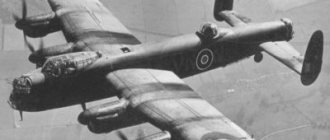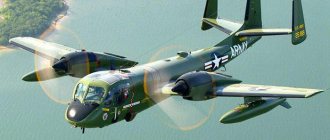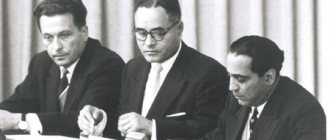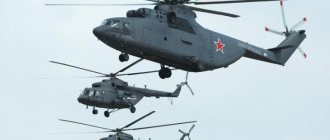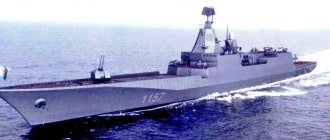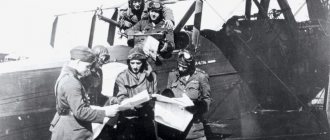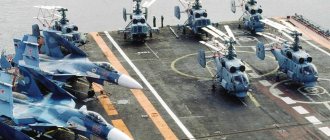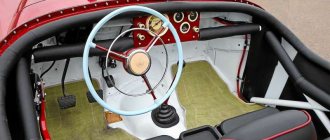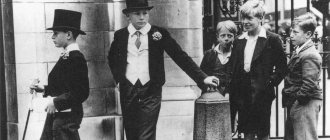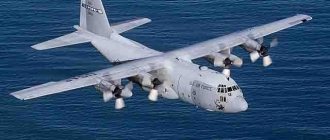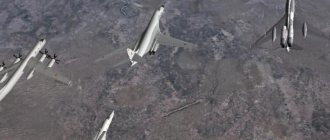HISTORY OF THE DEVELOPMENT OF AVIATION OF THE US NAVY
The formation of naval aviation occurred as follows. For the first time, a heavier-than-air aircraft, the Curtis D biplane, took off from a warship - the light cruiser Birmingham - on November 14, 1910 (pilot - American pilot Eugene Eli). At the same time, he was anchored in the Hampton roadstead near the Norfolk naval base (Virginia). To ensure the take-off of the aircraft, a 25 m long wooden ramp with a slope towards the stem was equipped on the deck of the cruiser's forecastle between the bow main gun turret and the stem, which increased the take-off speed.
The head of the tests (aircraft designer Glenn Curtis) proposed conducting them with the ship moving against the wind, which would create additional lift. However, at the insistence of Yu. Eli, the takeoff was carried out from a stationary ship. The tests could have ended in disaster because the plane did not reach the required takeoff speed during takeoff. The height of the cruiser's tank from the water's edge was 11.2 m, and the biplane, picking up speed while descending, touched the water surface and damaged the propeller. However, the pilot was able to keep the car in the air and, after flying 4 km, landed safely near the village of Willoughby Spit (Virginia).
At the end of 1910, the US Navy began preparations for the next element - landing on the deck of a ship. For this purpose, on the heavy cruiser Pennsylvania, a wooden landing ramp measuring 36.6 x 9.7 m was mounted above the poop deck and the main caliber aft artillery turret. Its inclination towards the stern of the ship was 5-6°, which provided additional braking during the run . Primitive aerofinishers were also used, which were 45-kg sandbags tied in pairs by cables, located in 10 rows along the sides of the ramp. During landing, the landing gear caught on the cables between the bags, and thus the aircraft was slowed down.
The biplane made its first landing on January 18, 1911. The cruiser Pennsylvania was anchored in San Francisco Bay (California). The Curtis D-IV biplane, piloted by Yu. Eli, took off from the Presidio airfield and landed on the ship's ramp. Moreover, thanks to the “sand” aerofinishers, the plane’s mileage was only 9.1 m. A few hours later, the pilot, having taken off from the deck of the cruiser, returned safely to his airfield.
The honor of the first takeoff from the deck of a moving ship belongs to the British pilot Lieutenant Commander Charles Samson. On January 10, 1912, in a Short S.27 biplane, he took off from the ramp on the forecastle of the battleship Africa, which was moving at a speed of 10.5 knots. The officer took off again on May 12, 1912 from the battleship Hibernia at the Royal Review of the British Navy at Portland Naval Base.
May 8, 1911 is considered the birthday of American Navy aviation. On this day, the Ministry of the Navy acquired the first two Curtis D-IV biplanes. Marine Corps Aviation of the US Navy dates back to May 22, 1911, when the third aircraft purchased for the fleet was transferred to the Marine Corps. Since then, for more than 100 years, the US military-political leadership has been paying increased attention to the development of naval aviation, and especially its aircraft carrier component.
By the time the United States entered World War I in April 1917, the naval air force had 54 aircraft and three balloons, and by the time Japan attacked Pearl Harbor in December 1941 there were already about 5,300 of them. By the end of World War II, the U.S. Navy's fleet and marine corps had a total of more than 15,000 aircraft of various types in service.
According to foreign military experts, carrier aircraft played a key role in the war at sea both in the Atlantic (the fight against the submarine forces of Nazi Germany) and in the Pacific Ocean (the defeat of the Imperial Japanese Navy). Thus, the first battle in history of large aircraft carrier groups took place in 1942 at Midway Atoll, as a result of which the Japanese fleet lost four heavy aircraft carriers and about 400 aircraft. It is considered a key moment in the fighting in the Pacific theater of war.
In the post-war years, the Navy command continued to pay attention to the development and expansion of the combat capabilities of its aircraft components. Naval aviation received carrier-based jet aircraft, nuclear and guided missile weapons, and helicopters of various types and purposes. The entire range of combat missions of naval aviation and all types of its support was practically worked out during the wars in Korea and Vietnam, as well as local military conflicts and operations (Libya, the Middle East, the Persian Gulf, Yugoslavia, Iraq, Afghanistan), where the air forces of the Navy demonstrated their combat capabilities and operational flexibility. Currently, the regular forces and reserve aviation of the US Navy have about 3,900 aircraft and helicopters, including about 1,300 in the Marine Aviation.
Selection of applicants
Only the company, which presented two separate projects, made it to the deadline of November 22, 1948. On November 19, 1948, the company's plant in El Segundo offered the 593 model, and the Santa Monica plant offered the 1181 model. According to management, this should have increased the likelihood of winning the competition, but there was also a risk of being an outsider with both cars.
The remaining applicants submitted their projects late; only by December 3, 1948, Lockheed and North American were not allowed to participate in the tender, because submitted designs that did not comply with OS-111 requirements.
examined at least 8 basic designs, ranging from L-187-1 to L-187-8, among which there were also quite non-standard ones. She did not have time to complete all the work and submitted only two projects to the competition, differing in the power plant. The L-187-2 model had two twin XJ-40 turbojet engines on pylons under a swept wing, and the L-187-7 had two XT-44-A turboprop engines with highly efficient coaxial six-blade propellers. This was the only theater design in this competition, and it was unsuccessful - its combat radius and maximum speed were unsatisfactory. The promise to complete the L-187-8 project with promising TJ-6 turbojet engines was not taken into account, since the company no longer had time for this.
The L-187-2 model had two twin XJ-40 turbojet engines on pylons under a swept wing
Lockheed Model L-187-7 with two XT-44-A turboprop engines
The NorthAmerican RD-4554 project was an evolution of the Savage with two TJ-6 turbojet engines at the root of the swept wing. An interesting feature was the articulation of the volumetric fuselage, wing and engine nacelles, into which the main landing gear was retracted. This solution was reminiscent of the rudiments of an integral layout, but in this case it reduced drag. Documents submitted to the Bureau on November 19, 1948 indicated that analysis of various aerodynamic designs, including swept and forward-swept wings, showed that it was not possible to create a design that would satisfy the requirements of OS111. Particularly difficult was the problem of achieving the combat radius, regardless of the type of AD and the use of a wing with a large relative aspect ratio. The minimal number of surviving drawings showing three views and internal layouts suggests that the competition was a low priority for the company.
NorthAmerican RD-4554 layout
and Fairchild proposed such original designs that the fleet leadership did not even consider them, considering them too risky.
The Model 245, combining the speed and altitude of a guided missile with the range and accuracy of a manned aircraft, had to meet not only OS-111 requirements, but also compete with the long-range special attack designs considered under OS-115 requirements.
Martin Model 245, shaped like the British Avro Vulcan
The “flying wing” with a span of 32 m and weighing about 50 tons could operate from water, from aircraft carriers and from coastal bases and had replaceable resettable take-off landing gear.
An even more unconventional proposal came from Fairchild, based on an earlier design for the M-121 bomber for the US Air Force. The M-128 project was “tailored” to aircraft carrier deployment and OS-111 requirements.
Its powerplant included six XJ-46s located at the rear of the fuselage, around a cylindrical bomb bay. The bomb was thrown against the direction of flight (backwards); a similar solution was implemented later on the A-5 Vigilent. Moreover, to achieve range characteristics, a jettisonable fuel tank was provided in the form of a wing, which also facilitated takeoff. A kind of jet-swept biplane weighing 50 tons, designed according to the “duck” configuration.
Image of the Fairchild M-128 model at the moment of launch from a smooth-deck aircraft carrier
The high degree of technical novelty and the associated degree of risk, and for Fairchild also the lack of experience in building such large and complex aircraft for the fleet, prevented these bold and radical designs from the two firms from moving beyond the drawing boards.
The next contender for victory was the NP-50 from Republic. Its elegant aerodynamic design was based on the XF-91 Thunderceptor, which was then being developed for the Air Force. The NP-50 had a mid-swept wing, on which engine nacelles were located with two XJ40-WE-12 and two XJ46-WE-2, in pairs. The supporting side struts of the bicycle chassis were installed in front of the line of folding parts of the wing consoles. The V-shaped tail unit completed the look. With a take-off weight of 48.6 tons, the aircraft had a length of 29.3 and a span of 25.9 m.
Model NP-50 from Republic
Apart from its fellow company from Santa Monica, Douglas ElSegundo had two most dangerous competitors left - the projects and the Curtiss P-558, which were distinguished by the depth of their development.
The situation with Douglas’s two projects was reminiscent of the joke about two Jews selling two identical goods side by side at different prices. However, it should be borne in mind that both the Model 1181 and the Convair model were equipped with three XJ40 turbojet engines and were heavier and larger than the Douglas 593 and Curtiss P-558 projects.
The maximum take-off weight of the 1181 model varied from 45 to 61 tons; in the overload version of the 1181-4, the Convair barely fit into 45.36 tons. At the same time, the dimensions of both structures, both in length and in wing span, were 2-3 m larger finalists of the competition.
The brilliant foresight of Heinemann, who believed that in conditions of uncertainty with the CVA-58 project, the new attack aircraft should have a take-off weight that would allow it to operate from existing Midway and even Essex-class aircraft carriers, was justified - the winners of the competition for the XVA (H1) were the following companies: with such projects.
General view drawing of Douglas Model 1181
TASKS, STRUCTURE, MAIN PROGRAMS OF US Navy AVIATION
The command of the US Armed Forces considers fleet aviation as a universal means of armed warfare, designed to solve a wide range of tasks in both oceanic and continental theaters of operations. According to American military experts, carrier-based aircraft are capable of hitting more than 70% of strategically important targets on the territory of potential enemy states. It plays a special role when conducting combat operations in theaters remote from the United States, as was demonstrated during counter-terrorism operations in Iraq and Afghanistan. According to the Navy command, only this type of aviation, as part of diverse fleet operational formations deployed in forward zones, is capable of providing an effective solution to problems during the initial phase of any regional conflict.
The F-3SB Lightning 2 fighter-attack aircraft is practicing the combat use of JDAM-type UAB |
The most significant programs in the field of development of US Navy aviation are: the purchase and development of the F-35B fighter-attack aircraft (for marine aviation) and the F-35C Lightning-2 (for carrier-based fleet aviation), the P-8A Poseidon anti-submarine aircraft, the DELO and U E-2D Super Hawkeye aircraft, the MQ-4C Triton unmanned aerial vehicle; continued deliveries of carrier-based electronic warfare aircraft E/A-18G "Growler", multi-purpose helicopters MH-60S "Night Hawk" and anti-submarine MH-60R "Strike Hawk", airborne transport aircraft MV-22B "Osprey", fire support helicopters AH-1Z "King Cobra", UH-1Y "Venom" combat support helicopters, as well as the MQ-SB "Fire Scout" helicopter-type UAV. In addition, R&D is underway to create the CH-53K Super Stellen transport helicopter, a carrier-based attack UAV based on the X-47B, and an MQ-8C helicopter-type UAV.
Administratively, Fleet Aviation, like the Navy as a whole, is led by the Secretary of the Navy (civilian) and the Chief of Naval Staff (Washington, DC) through the Commander, US Naval Air Forces - Headquarters at North Island Air Force Base (California), who is simultaneously the commander of the air forces of the Pacific Fleet (Commander, Naval Air Force, US Pacific Fleet) and the subordinate commander of the air forces of the Atlantic Fleet (Commander, Naval Air Force, Atlantic) - headquarters at the AB Norfolk.
The following are directly subordinate to the Commander of the Naval Air Forces:
- Deputy Commander of the Naval Air Forces (Deputy Commander, Naval Air Forces) - First Deputy Commander of the Pacific Fleet Air Force (Vice-Commander, Naval Air Forces, US Pacific Fleet), who is also the Commander, Navy Air Force Reserve ); headquarters is based at AB Norfolk;
- Commander, Fleet Air Forward, headquartered at Atsugi Air Base (Japan);
- Deputy Commander, Naval Air Forces for Training - Chief of Naval Air Training, headquartered at Corpus Christi Air Force Base, Texas.
AWACS and control aircraft E-2D "Super Hawkeye" |
A special place in the Navy's air forces is occupied by the Naval Air Systems Command, headquartered at Patuxent River Air Base (Maryland). This body is a centrally subordinate coastal command. It is entrusted with the task of creating and conducting comprehensive tests of new aircraft and weapons, as well as airborne means of countering enemy air defenses, detecting and identifying targets, target designation, reconnaissance, communications and control.
The structure of this command includes the Naval Air Warfare Center, which consists of two divisions: AT testing (Air Division) at the Patuxent River airbase and weapons testing (Weapon Division) at the China Lake airbase (California) .
In the interests of the center for the combat use of Navy aviation, test wings of the Atlantic (AF Patac St. River) and Pacific (AF Point Mugu, California) fleets have been created.
In total, the above formations include more than 100 aircraft and helicopters of various types, which are used for flight and ground testing during targeted R&D.
The commanders of the air forces of the Atlantic and Pacific fleets are the commanders of the air wings of carrier and base aviation. Air squadrons from their composition are included in the air wings of aircraft carrier strike groups (AUG) and UUV groups of operational fleets (3 OF - eastern and central parts of the Pacific Ocean, 4 OF - Central and South America zone, 5 OF - OCC zone, 6 OF - European and African zones, 7 OF - western part of the Pacific Ocean).
Identification marks
- Roundel of the USAF.svg
US Navy aviation insignia
- AFG-080923-003.jpg
Reduced visibility option
- Usaf roundel.gif
Construction
Evolution of identification marks
| Identification mark | Fuselage badge | Keel mark | When used | Application order |
| No | August 1919 - May 1942 | |||
| No | May 1942 - June 1943 | |||
| No | June 1943 - September 1943 | |||
| No | September 1943 - January 1947 | |||
| No | January 1947 - present day |
AIR FORCE ATLANTIC FLEET (ATF)
F/A-18D Hornet fighter-attack aircraft |
According to the administrative organization of the US Navy, they include four air wings of homogeneous forces:
- fighter-assault ATF (Strike Fighter Wing Atlantic),
- 11th Patrol and Reconnaissance Wing 11,
- anti-submarine helicopter ATF (Helicopter Maritime Strike Wing Atlantic) and combat helicopter ATF (Helicopter Sea Combat Wing Atlantic),
- three separate air squadrons.
Despite the significant difference in the number of subordinate air squadrons and, accordingly, in the availability of aviation equipment and the available number of personnel, the commanders of all air wings, individual, combat training and test squadrons have the military rank of captain (captain 1st rank), and the commanders of the remaining air squadrons - commander (2nd rank captain).
The air wing commander is responsible for the training of flight and technical personnel, the condition of aircraft equipment, the staffing of the formation and all types of logistical support for units.
Each air wing has its own coat of arms and motto, and each air squadron has a coat of arms, name and letter code, which is applied to the wings of aircraft, as well as to the vertical tail of aircraft and helicopters.
Combat composition
| Formation or unit designation | Armament and equipment | Location | |||
| 1st Carrier Air Wing | |||||
| 11th Fighter Bomber Squadron | |||||
| 136th Fighter Bomber Squadron | |||||
| 211th Fighter Bomber Squadron | |||||
| 123rd Aircraft AWACS Squadron | |||||
| Carrier Electronic Warfare Squadron 137 | |||||
| 40th Logistics and Fleet Support Squadron, 2nd Aviation Squadron | |||||
| 11th Anti-Submarine Helicopter Squadron | |||||
| 2nd Carrier Air Wing | |||||
| 2nd Fighter Bomber Squadron | |||||
| 34th Fighter Bomber Squadron | |||||
| 137th Fighter Bomber Squadron | |||||
| 151st Fighter Bomber Squadron | |||||
| 116th Aircraft AWACS Squadron | |||||
| Carrier Electronic Warfare Squadron 131 | |||||
| 30th Logistics and Fleet Support Squadron, 2nd Aviation Squadron | |||||
| Naval Combat Helicopter Squadron 12 | |||||
| Naval Attack Helicopter Squadron 77 | |||||
| 3rd Carrier Air Wing | |||||
| 32nd Fighter Bomber Squadron | |||||
| 37th Fighter Bomber Squadron | |||||
| 105th Fighter Bomber Squadron | |||||
| 126th Aircraft AWACS Squadron | |||||
| Carrier Electronic Warfare Squadron 130 | |||||
| 40th Logistics and Fleet Support Squadron, 1st Aviation Squadron | |||||
| 7th Anti-Submarine Helicopter Squadron | |||||
| 5th Carrier Air Wing | |||||
| 7th Carrier Air Wing | |||||
| 8th Carrier Air Wing | |||||
| 9th Carrier Air Wing | |||||
| 11th Carrier Air Wing | |||||
| 14th Carrier Air Wing | |||||
| 17th Carrier Air Wing | |||||
PACIFIC AIR FORCE
Basic patrol aircraft R-8A "Poseidon" |
Includes nine air wings, including:
- fighter-assault Pacific Fleet (Strike Fighter Wing Pacific);
- combat control and logistics support (Command and Control Logistics Wing); electronic warfare wing (Electronic Attack Wing Pacific);
- 1 acre of Strategic Communication Wing 1;
- 2, 10 and 57th patrol and reconnaissance wings (Patrol and Reconnaissance Wing: 2,10, and 57);
- anti-submarine helicopter (Helicopter Maritime Strike Wing Pacific);
- combat helicopter (Helicopter Sea Combat Wing Pacific).
In the system of administrative organization of Pacific Fleet aviation, a special place is occupied by the following formations: an electronic warfare wing, an air wing of combat control and logistics support, as well as 1 acre of strategic communications. This is due to the fact that the first two allocate air squadrons to the carrier air wings of the Pacific Fleet and ATF, and the third is a connection of repeater aircraft of the TAKAMO system and air command posts, which is designed to provide backup communications with SSBNs of the US Navy located in combat patrol areas . Taking into account the fact that this wing is based in the central part of the United States at Tinker Air Base (Oklahoma), air squads are allocated from its composition on a rotation basis, which are located at Patuxent River Air Base (Maryland) and Travis (California).
From the 2, 10 and 11 patrol and reconnaissance wings, patrol squadrons and aircraft detachments are allocated on a rotational basis for combat service in forward zones based at AB Sigonela (Sicily, Italy), Comalapa (El Salvador), Misawa (Japan). ), Kadena (Okinawa Island) and El Udeid (Qatar).
Notes
- [www.history.navy.mil/branches/usna1910.htm United States Naval Aviation 1910-1995]
- [www.navy.mil/navydata/bios/navybio.asp?bioID=224 Commander, Naval Air Forces]
- [www.aviationweek.com/aw/sourcebook/content.jsp?channelName=pro&story=xml/sourcebook_xml/2009/01/26/AW_01_26_2009_p0240-112924-158.xml&headline=World%20Military%20Aircraft%20Inventory%20-%20United+ States Aviation Week & Space Technology
, 2009 World Military Aircraft Inventory, United States] (inaccessible link since 09/04/2013 (3063 days) -
history
,
copy
) - ↑ 12
[www.navy.mil/navydata/navy_legacy_hr.asp?id=266 Rank Insignia of Navy Commissioned and Warrant Officers] - Only in wartime
- [www.rubricon.com/pr_americana_13.asp English-Russian linguistic and cultural dictionary “Americana” / Americana English-Russian Encyclopedic Dictionary edited by Professor G. V. Chernov]
- [www.navy.mil/navydata/navy_legacy_hr.asp?id=260 Rate Insignia of Navy Enlisted Personnel]
- On the headdress and collar.
US MARINE AVIATION
Fire support helicopter AH-1Z "King Cobra" |
Within the administrative organization of the Navy, it has its own characteristics. In particular, its regular composition includes three air wings (MAW - Marine Air Wing), which are simultaneously an air reinforcement component for three divisions of regular Marine Corps forces in the formation of Marine expeditionary formations. In turn, they are divided into air groups (MAG - Marine Air Group).
Administrative control of MP aviation is also carried out by the Commandant of the US Navy Marine Corps through his assistant for aviation.
Subordinate to the Commander of ATF Marine Forces is the commander of the 2nd Marine Aircraft Wing (2 MAW), whose headquarters is located at Cherry Point Air Force Base (North Carolina). The air wing includes four air groups and three separate air squadrons.
Subordinate to the Commander of the Pacific Fleet Marine Forces are the commanders of the 1st and 3rd Marine Air Wings (1 and 3 MAW), whose headquarters are located at Iwakuni Air Base (Japan) and Miramar (California), respectively.
The first of them, which, with the exception of a separate mixed air group based at Air Force Base Kaneohe Bay (Hawaii), does not have a permanent composition, is equipped with air squadrons and air detachments from the 2nd and 3rd air wings of the MP on a rotation basis.
Insignia
Admirals and officers
| Categories[4] | Admirals | Officers | ||||||||||
| Metallic badge Shoulder strap | ||||||||||||
| English speaking title | Fleet Admiral [5] | Admiral | Vice Admiral | Rear Admiral (upper half) | Rear Admiral (lower half) | Captain | Commander | Lieutenant Commander | Lieutenant | Lieutenant Junior Grade | Ensign | |
| Translation[6] | Fleet Admiral | Admiral | Vice Admiral | Rear Admiral | Captain | Commander | Lieutenant Commander | Lieutenant | Ensign | Ensign | ||
| Russian compliance | Fleet Admiral | Admiral | Vice Admiral | Rear Admiral | No | Captain 1st rank | Captain 2nd rank | Captain 3rd rank | Lieutenant Commander | Senior Lieutenant | Lieutenant | |
Sub-officers
| Categories[4] | Sub-officers | |||
| Metallic badge Shoulder strap | ||||
| English rank | Chief Warrant Officer (5) | Chief Warrant Officer (4) | Chief Warrant Officer (3) | Chief Warrant Officer (2) |
| Russian name | Chief Warrant Officer Class 5 | Chief Warrant Officer 4th Class | Chief Warrant Officer 3rd Class | Chief Warrant Officer 2nd Class |
| Russian compliance | No | No | No | |
Petty Officers and Sailors
| Categories[7] | Petty Officers | Sailors | ||||||||
| Metal sign[8] | No | No | No | |||||||
| Chevron | No | |||||||||
| English rank | Master Chief Petty Officer of the Navy | Master Chief Petty Officer | Senior Chief Petty Officer | Chief Petty Officer | Petty Officer First Class | Petty Officer Second Class | Petty Officer Third Class | Seaman | Seaman Apprentice | Seaman Recruit |
| Russian name | Master Chief Petty Officer BMC | Master Chief Petty Officer | First Chief Petty Officer | Chief Petty Officer | Petty Officer First Class | Petty Officer Second Class | Petty Officer Third Class | Sailor | Junior sailor | Sailor recruit |
| Russian compliance | — | Chief petty officer | — | Chief Petty Officer | Petty Officer 1st Article | Petty Officer 2nd Article | Senior sailor | Sailor | — | — |
US NAVY AIR RESERVE
The first air reserve unit in the US Navy was formed in 1916. The main tasks of the naval aviation reserve components are to ensure the preparation of their air squadrons for combat operations and to make up for possible losses in the flight personnel and AT of the regular forces, where they are transferred during the mobilization deployment of naval forces.
The commander of the Naval Aviation Reserve is administratively subordinate to the commander of the reserve and the assistant chief of staff of the Navy for the combat use of fleet air forces. The reserve structure currently includes the following formations and units: a Tactical Support Wing, a Fleet Logistic Support Wing, as well as two patrol and three helicopter squadrons.
The Marine Corps Aviation Reserve is currently represented by the 4th Marine Aircraft Wing (4 MAW), which includes two air groups.
US Navy FLIGHT TRAINING DEPARTMENT
The organizational structure of the management includes five training air wings (TAW - Training Air Wing): the 1st training wing, which is stationed at Meridian Air Base (Mississippi), as well as the 2nd, 4th, 5th and 6th at the Kingsville and Corpus Christi air bases ( Texas), Whiting Field and Pensacola (Florida), respectively. Each of them specializes in training pilots for certain branches of naval aviation.
Flight and technical personnel of the Navy, Marine Corps, and US Coast Guard undergo a full training course in these training units. At the same time, carrier-based aviation pilots complete it with practical training in takeoff and landing on the deck of an aircraft carrier. In the future, training of flight personnel is carried out in combat training squadrons of the air forces of the fleets, where the technique of piloting aircraft and helicopters of a certain type is fully developed, as well as air combat tactics and the combat use of aviation weapons.
The average pilot flight time during training is 200-250 hours, depending on the types of aircraft (helicopters).
